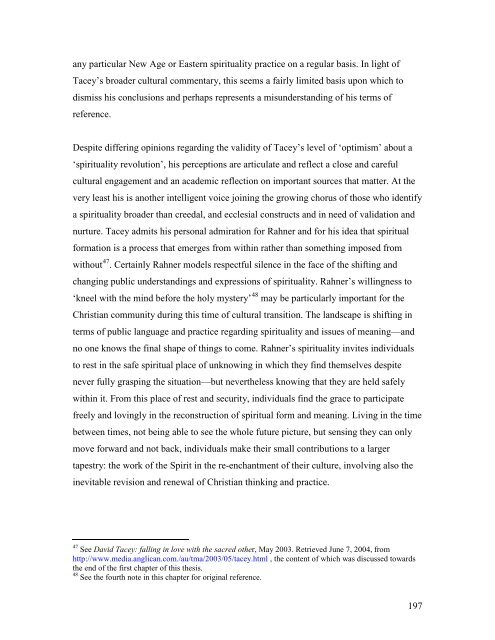Introductory notes for readers of this thesis - Theses - Flinders ...
Introductory notes for readers of this thesis - Theses - Flinders ...
Introductory notes for readers of this thesis - Theses - Flinders ...
Create successful ePaper yourself
Turn your PDF publications into a flip-book with our unique Google optimized e-Paper software.
any particular New Age or Eastern spirituality practice on a regular basis. In light <strong>of</strong>Tacey’s broader cultural commentary, <strong>this</strong> seems a fairly limited basis upon which todismiss his conclusions and perhaps represents a misunderstanding <strong>of</strong> his terms <strong>of</strong>reference.Despite differing opinions regarding the validity <strong>of</strong> Tacey’s level <strong>of</strong> ‘optimism’ about a‘spirituality revolution’, his perceptions are articulate and reflect a close and carefulcultural engagement and an academic reflection on important sources that matter. At thevery least his is another intelligent voice joining the growing chorus <strong>of</strong> those who identifya spirituality broader than creedal, and ecclesial constructs and in need <strong>of</strong> validation andnurture. Tacey admits his personal admiration <strong>for</strong> Rahner and <strong>for</strong> his idea that spiritual<strong>for</strong>mation is a process that emerges from within rather than something imposed fromwithout 47 . Certainly Rahner models respectful silence in the face <strong>of</strong> the shifting andchanging public understandings and expressions <strong>of</strong> spirituality. Rahner’s willingness to‘kneel with the mind be<strong>for</strong>e the holy mystery’ 48 may be particularly important <strong>for</strong> theChristian community during <strong>this</strong> time <strong>of</strong> cultural transition. The landscape is shifting interms <strong>of</strong> public language and practice regarding spirituality and issues <strong>of</strong> meaning—andno one knows the final shape <strong>of</strong> things to come. Rahner’s spirituality invites individualsto rest in the safe spiritual place <strong>of</strong> unknowing in which they find themselves despitenever fully grasping the situation—but nevertheless knowing that they are held safelywithin it. From <strong>this</strong> place <strong>of</strong> rest and security, individuals find the grace to participatefreely and lovingly in the reconstruction <strong>of</strong> spiritual <strong>for</strong>m and meaning. Living in the timebetween times, not being able to see the whole future picture, but sensing they can onlymove <strong>for</strong>ward and not back, individuals make their small contributions to a largertapestry: the work <strong>of</strong> the Spirit in the re-enchantment <strong>of</strong> their culture, involving also theinevitable revision and renewal <strong>of</strong> Christian thinking and practice.47 See David Tacey: falling in love with the sacred other, May 2003. Retrieved June 7, 2004, fromhttp://www.media.anglican.com./au/tma/2003/05/tacey.html , the content <strong>of</strong> which was discussed towardsthe end <strong>of</strong> the first chapter <strong>of</strong> <strong>this</strong> <strong>thesis</strong>.48 See the fourth note in <strong>this</strong> chapter <strong>for</strong> original reference.197















